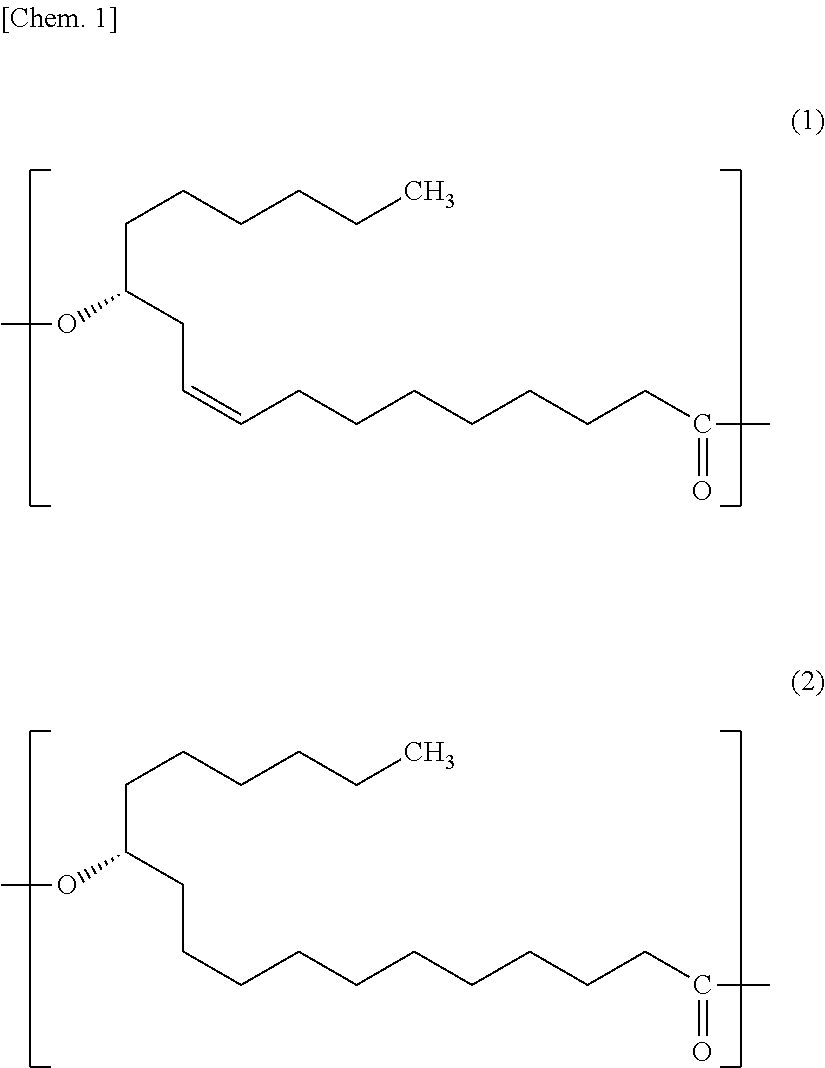Copolymer and lubricating oil composition
a technology of lubricating oil and copolymer, which is applied in the direction of lubricant compositions, base materials, additives, etc., to achieve the effects of reducing the discoloration of heating, excellent workability, and biodegradability
- Summary
- Abstract
- Description
- Claims
- Application Information
AI Technical Summary
Benefits of technology
Problems solved by technology
Method used
Image
Examples
example 1-1
Production of Copolymer B-1
[0202]40.0 Parts by mass of ricinolic acid, 5.8 parts by mass of sebacic acid and 5.2 parts by mass of 1,4-butanediol were heated up to 210° C. from ordinary temperature over a period of 30 minutes. After the temperature reached 210° C., 0.20 part by mass of titanium tetrabutoxide and 0.03 part by mass of a 20 wt % aqueous solution of ethylammonium hydroxide were added, and the resulting mixture was maintained as it was at 210° C. for 5 hours, thereby carrying out esterification reaction.
[0203]After completion of the esterification reaction, 1.36 parts by mass of titanium tetrabutoxide were added as a polymerization catalyst, and while raising the temperature up to 230° C. over a period of 60 minutes, the pressure was reduced down to 0.133 kPa (1 Torr), thereby carrying out polycondensation reaction. This polycondensation reaction was carried out while stirring the reaction mixture. Here, as the polycondensation reaction proceeded, stirring torque required...
example 1-2
Production of Copolymer B-2
[0204]40.0 Parts by mass of ricinolic acid, 10.2 parts by mass of adipic acid and 9.7 parts by mass of 1,4-butanediol were heated up to 210° C. from ordinary temperature over a period of 30 minutes. The subsequent procedure was carried out in the same manner as in Example 1-1 to give a polyester.
example 1-3
Production of Copolymer B-3
[0205]40.0 Parts by mass of ricinolic acid, 13.6 parts by mass of sebacic acid and 9.7 parts by mass of 1,4-butanediol were heated up to 210° C. from ordinary temperature over a period of 30 minutes. The subsequent procedure was carried out in the same manner as in Example 1-1 to give a polyester.
PUM
| Property | Measurement | Unit |
|---|---|---|
| Percent by mole | aaaaa | aaaaa |
| Percent by mole | aaaaa | aaaaa |
| Percent by mole | aaaaa | aaaaa |
Abstract
Description
Claims
Application Information
 Login to View More
Login to View More - R&D
- Intellectual Property
- Life Sciences
- Materials
- Tech Scout
- Unparalleled Data Quality
- Higher Quality Content
- 60% Fewer Hallucinations
Browse by: Latest US Patents, China's latest patents, Technical Efficacy Thesaurus, Application Domain, Technology Topic, Popular Technical Reports.
© 2025 PatSnap. All rights reserved.Legal|Privacy policy|Modern Slavery Act Transparency Statement|Sitemap|About US| Contact US: help@patsnap.com

